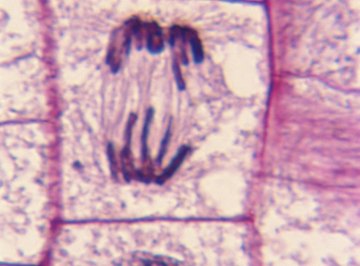
Chromosomes are the microscopic entities in living cells that contain the genetic information pertaining to the organism as a whole. Chromosomes consist of DNA (deoxyribonucleic acid, the information-carrying molecule in chromosomes) and structural proteins.
Right after a cell divides, it has one copy of each chromosome. Soon, each chromosome is replicated, or copied, in preparation for mitosis and another round of cell division.
A replicated chromosome (or equivalently, a duplicated chromosome) contains two identical chromatids, also called sister chromatids. The difference between a duplicated chromosome and a chromatid, strictly speaking, is that a chromosome contains two chromatids that are joined at a structure called a centromere.
A duplicated chromosome therefore includes two identical strands joined along their length at corresponding lengths of DNA.
The Role of Chromosomes
Chromosomes are nothing more than distinct chunks of a substance called chromatin, which consists of very long molecules of DNA wrapped around special proteins known as histones. Different organisms have different numbers of chromosomes. Humans, for example, have 46.
In most prokaryotes (i.e., organisms in the domains Bacteria and Archaea), there is no more than a single chromosome in a ring conformation, which is adequate for the needs of a one- or few-celled organism.
In sexual reproduction in humans, a sperm cell carries half of the complete set of the father's DNA, and an egg cell holds half of the complete set of the mother's. When these fuse in the process of fertilization, a 46-chromosome zygote is formed, which soon becomes an embryo and then a fetus.
In essence, the first identifiable thing about you was the DNA in your freshly assembled chromosomes, unique in human history (unless you have an identical twin).
Homologous Chromosomes vs. Chromatids
Humans have 46 chromosomes, 23 from each parent; 22 these come in distinct pairs, meaning that the copy of chromosome 1 you inherited from your mother is structurally identical to the copy of chromosome 1 you inherited from your father, and so on for the other 21 "matched" chromosomes. The 23rd chromosome in each parental set is a sex chromosome, either X or Y.
These structurally identical chromosomes in pairs are called homologous chromosomes. Differences between these homologous chromosomes occur only at the level of the nucleotide base sequences of the DNA of each chromosome.
Chromosome Replication
Recall that DNA is double-stranded. When the two strands become physically separated by enough to allow each strand to be copied, one of two things could potentially happen to create two double-stranded "daughter" copies of the DNA.
First, each of the two newly synthesized strands could remain bound to the template strand from which it was created. Or, the two "old" strands could rejoin while the two just-synthesized strands bind to each other.
The former scenario is what in fact occurs, and is called semiconservative replication, since each "new" double-stranded DNA molecule is actually half "old" and half "new." (In conservative replication, old molecules and new molecules remain segregated with every successive replication cycle.)
This means that each "new" chromosome, called a chromatid, contains an equal mixture of "old" and "new" material. The chromatids together, joined at their shared centromere, constitute a duplicated chromosome.
DNA replication happens during the interphase of a cell's life cycle – the period after a newly formed cell has "settled down" and begun duplicating all of its parts in readiness for the next mitosis and cell division. Cells spend most of their lives in interphase.
Mitosis Phases
Mitosis, the division of the eukaryotic cell's nucleus into two identical daughter nuclei, follows interphase and directly precedes the division of the parent cell itself (cytokinesis). It consists of five phases:
- Prophase
- Prometaphase
- Metaphase
- Anaphase
- Telophase/Cytokinesis
The sum total of these phases is that the centromeres of duplicated chromosomes form a straight line in the about-to-divide nucleus, and one chromatid in each set is pulled to a different side of the dividing nucleus.
When the cell divides, each daughter cell now has one un-duplicated chromosome, which the cell will then rectify when DNA replication begins anew in interphase.
References
About the Author
Kevin Beck holds a bachelor's degree in physics with minors in math and chemistry from the University of Vermont. Formerly with ScienceBlogs.com and the editor of "Run Strong," he has written for Runner's World, Men's Fitness, Competitor, and a variety of other publications. More about Kevin and links to his professional work can be found at www.kemibe.com.
Photo Credits
Jupiterimages/Photos.com/Getty Images
